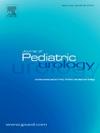ROS清除剂与尿道下裂男孩生殖器皮肤愈合。
IF 1.9
3区 医学
Q2 PEDIATRICS
引用次数: 0
摘要
尿道下裂修复术的并发症发生率高。与对照组相比,尿道下裂男孩的血管细胞活性氧(ROS)增加。目前尚不清楚ROS是否影响尿道下裂的伤口愈合。目的:本研究的目的是确定尿道下裂是否会改变生殖器皮肤的细胞迁移和增殖,以及抗氧化剂是否会改变这种情况。研究设计:生殖器皮肤成纤维细胞(gsf)是由接受尿道下裂修复术或常规包皮环切术的男孩培养的。细胞在创面划伤后立即成像,48小时后,在存在/不存在ROS清除剂、n -乙酰半胱氨酸(NAC)或Tempol的情况下成像。使用ImageJ软件测定细胞迁移。使用Cell Count Kit-8 (Abcam, UK)检测细胞增殖。结果:共纳入24例(中位年龄1.8(1.2,6.3)岁)和28例对照组(1.6(1.2,6.1)岁)。患有尿道下裂的男孩在48小时内细胞迁移受损,伤口愈合减少(2.0倍,p)。活性氧清除剂增加尿道下裂男孩GSFs的细胞迁移和增殖。结论:需要进行转化研究来证实ROS清除剂是否可以作为改善尿道下裂男孩手术结果的治疗选择。本文章由计算机程序翻译,如有差异,请以英文原文为准。
ROS scavengers and genital skin healing in boys with hypospadias
Introduction
Hypospadias repair is associated with high complication rates. Vascular cells from boys with hypospadias have increased reactive oxygen species (ROS) compared to controls. It is not clear if ROS affects wound healing in hypospadias.
Objectives
The aim of this study is to identify if cell migration and proliferation in genital skin is altered in hypospadias, and whether this is altered by antioxidants.
Study design
Genital skin fibroblasts (GSFs) were grown from boys undergoing hypospadias repair or routine circumcision. Cells were imaged immediately after creating a wound scratch and 48 h later, in the presence/absence of ROS scavengers, N-acetylcysteine (NAC) or Tempol. Cell migration was determined using ImageJ software. Cell proliferation was measured using a Cell Count Kit-8 (Abcam, UK).
Results
Twenty-four cases (median age (range) 1.8 (1.2, 6.3) years) and 28 controls (1.6 (1.2, 6.1) years) were recruited. Boys with hypospadias had impaired cell migration with reduced wound closure at 48 h (2.0 fold, p < 0.0001) and reduced cell proliferation (1.3 fold, p = 0.01). External Masculinisation Score was positively correlated with wound closure (r = 0.5, p < 0.0001) and cell proliferation (r = 0.3, p = 0.002). Exposure to NAC and Tempol improved wound closure (1.9 fold, p = 0.01, and 1.5 fold, p = 0.02 respectively) and cell proliferation (1.5 fold, p = 0.02 and 1.4 fold, p = 0.05 respectively).
Discussion
There is an association between wound healing and virilisation of the external genitalia in boys. ROS scavengers increase cell migration and proliferation in GSFs from boys with hypospadias.
Conclusion
Translational studies are required to confirm whether ROS scavengers may represent a therapeutic option for improving surgical outcome in boys with hypospadias.
求助全文
通过发布文献求助,成功后即可免费获取论文全文。
去求助
来源期刊

Journal of Pediatric Urology
PEDIATRICS-UROLOGY & NEPHROLOGY
CiteScore
3.70
自引率
15.00%
发文量
330
审稿时长
4-8 weeks
期刊介绍:
The Journal of Pediatric Urology publishes submitted research and clinical articles relating to Pediatric Urology which have been accepted after adequate peer review.
It publishes regular articles that have been submitted after invitation, that cover the curriculum of Pediatric Urology, and enable trainee surgeons to attain theoretical competence of the sub-specialty.
It publishes regular reviews of pediatric urological articles appearing in other journals.
It publishes invited review articles by recognised experts on modern or controversial aspects of the sub-specialty.
It enables any affiliated society to advertise society events or information in the journal without charge and will publish abstracts of papers to be read at society meetings.
 求助内容:
求助内容: 应助结果提醒方式:
应助结果提醒方式:


